MBA403 Financial Analysis: Wealth Report on Woolworths Limited
VerifiedAdded on 2023/06/12
|7
|1353
|289
Report
AI Summary
This wealth report provides a financial analysis of Woolworths Limited, an Australian retail company, using its 2016 and 2017 annual reports. It focuses on key financial ratios such as profitability, short-term solvency, long-term solvency, market value, and asset utilization to assess the company's performance. The report interprets both financial and non-financial measures, including the discontinuation of the home improvement business, the opening of new stores, asset value decreases, and dividend declarations. Ultimately, the report recommends that potential investors consider investing in Woolworths, highlighting the increased net profit margin and earnings per share as key factors for wealth growth. Desklib provides access to similar solved assignments for students.
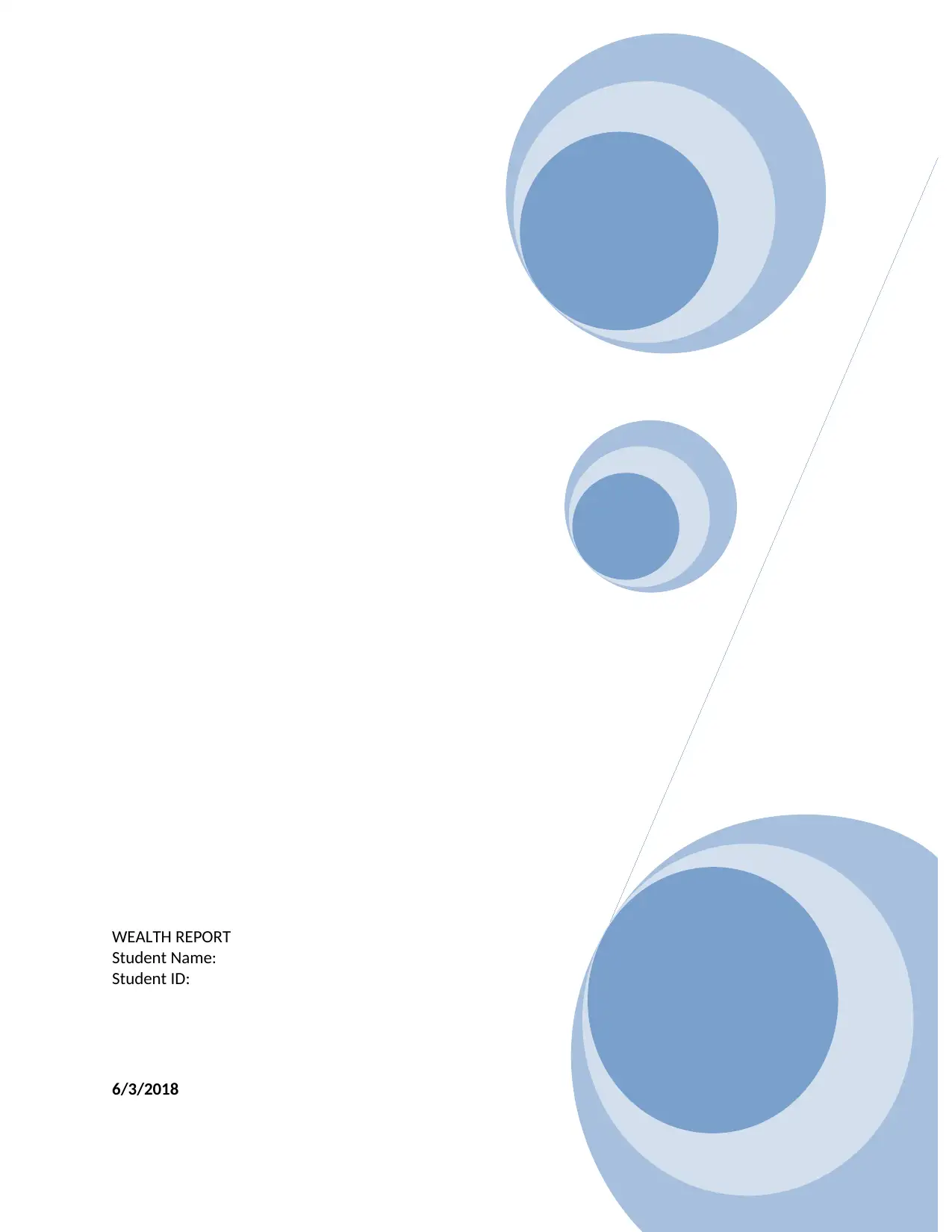
WEALTH REPORT
Student Name:
Student ID:
6/3/2018
Student Name:
Student ID:
6/3/2018
Paraphrase This Document
Need a fresh take? Get an instant paraphrase of this document with our AI Paraphraser
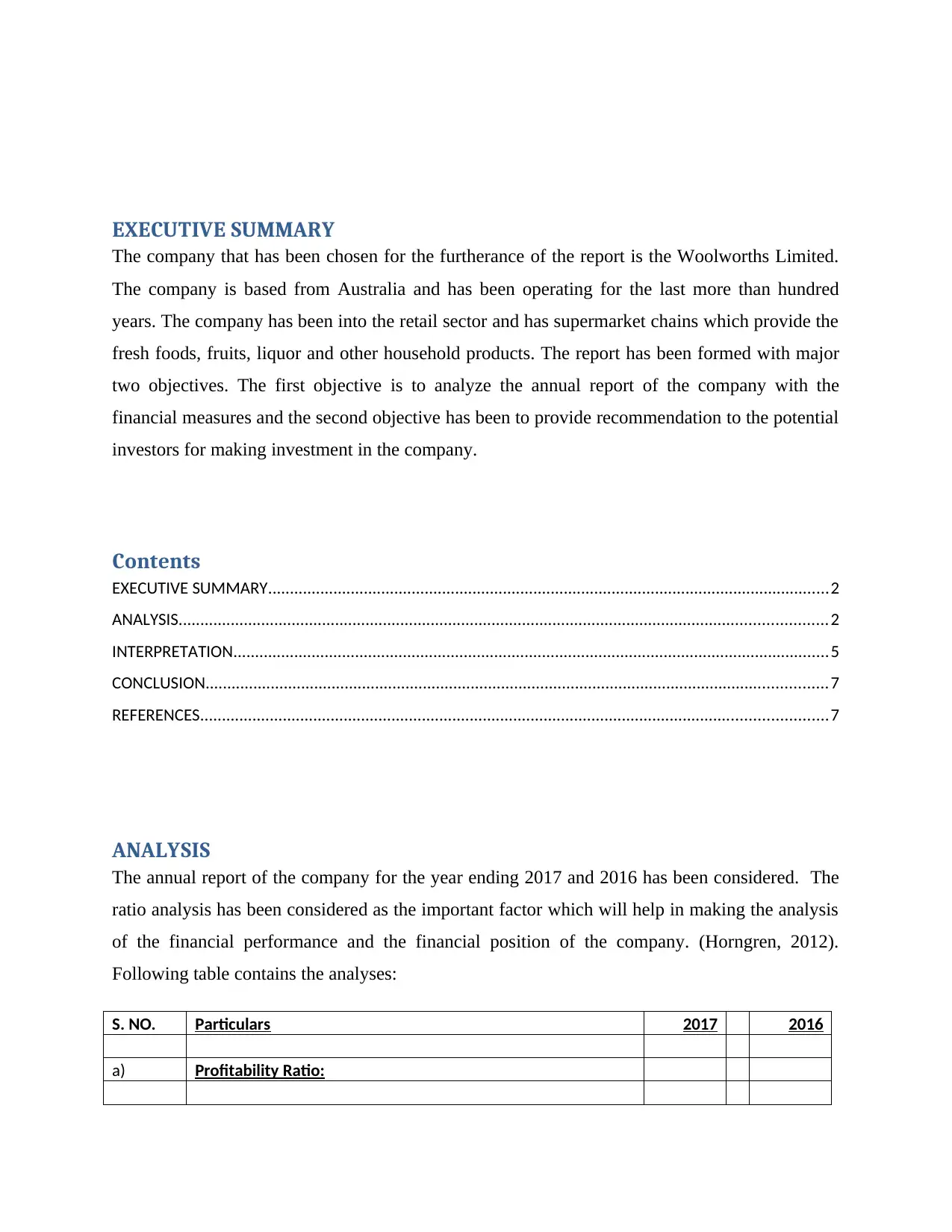
EXECUTIVE SUMMARY
The company that has been chosen for the furtherance of the report is the Woolworths Limited.
The company is based from Australia and has been operating for the last more than hundred
years. The company has been into the retail sector and has supermarket chains which provide the
fresh foods, fruits, liquor and other household products. The report has been formed with major
two objectives. The first objective is to analyze the annual report of the company with the
financial measures and the second objective has been to provide recommendation to the potential
investors for making investment in the company.
Contents
EXECUTIVE SUMMARY.................................................................................................................................2
ANALYSIS.....................................................................................................................................................2
INTERPRETATION.........................................................................................................................................5
CONCLUSION...............................................................................................................................................7
REFERENCES................................................................................................................................................7
ANALYSIS
The annual report of the company for the year ending 2017 and 2016 has been considered. The
ratio analysis has been considered as the important factor which will help in making the analysis
of the financial performance and the financial position of the company. (Horngren, 2012).
Following table contains the analyses:
S. NO. Particulars 2017 2016
a) Profitability Ratio:
The company that has been chosen for the furtherance of the report is the Woolworths Limited.
The company is based from Australia and has been operating for the last more than hundred
years. The company has been into the retail sector and has supermarket chains which provide the
fresh foods, fruits, liquor and other household products. The report has been formed with major
two objectives. The first objective is to analyze the annual report of the company with the
financial measures and the second objective has been to provide recommendation to the potential
investors for making investment in the company.
Contents
EXECUTIVE SUMMARY.................................................................................................................................2
ANALYSIS.....................................................................................................................................................2
INTERPRETATION.........................................................................................................................................5
CONCLUSION...............................................................................................................................................7
REFERENCES................................................................................................................................................7
ANALYSIS
The annual report of the company for the year ending 2017 and 2016 has been considered. The
ratio analysis has been considered as the important factor which will help in making the analysis
of the financial performance and the financial position of the company. (Horngren, 2012).
Following table contains the analyses:
S. NO. Particulars 2017 2016
a) Profitability Ratio:
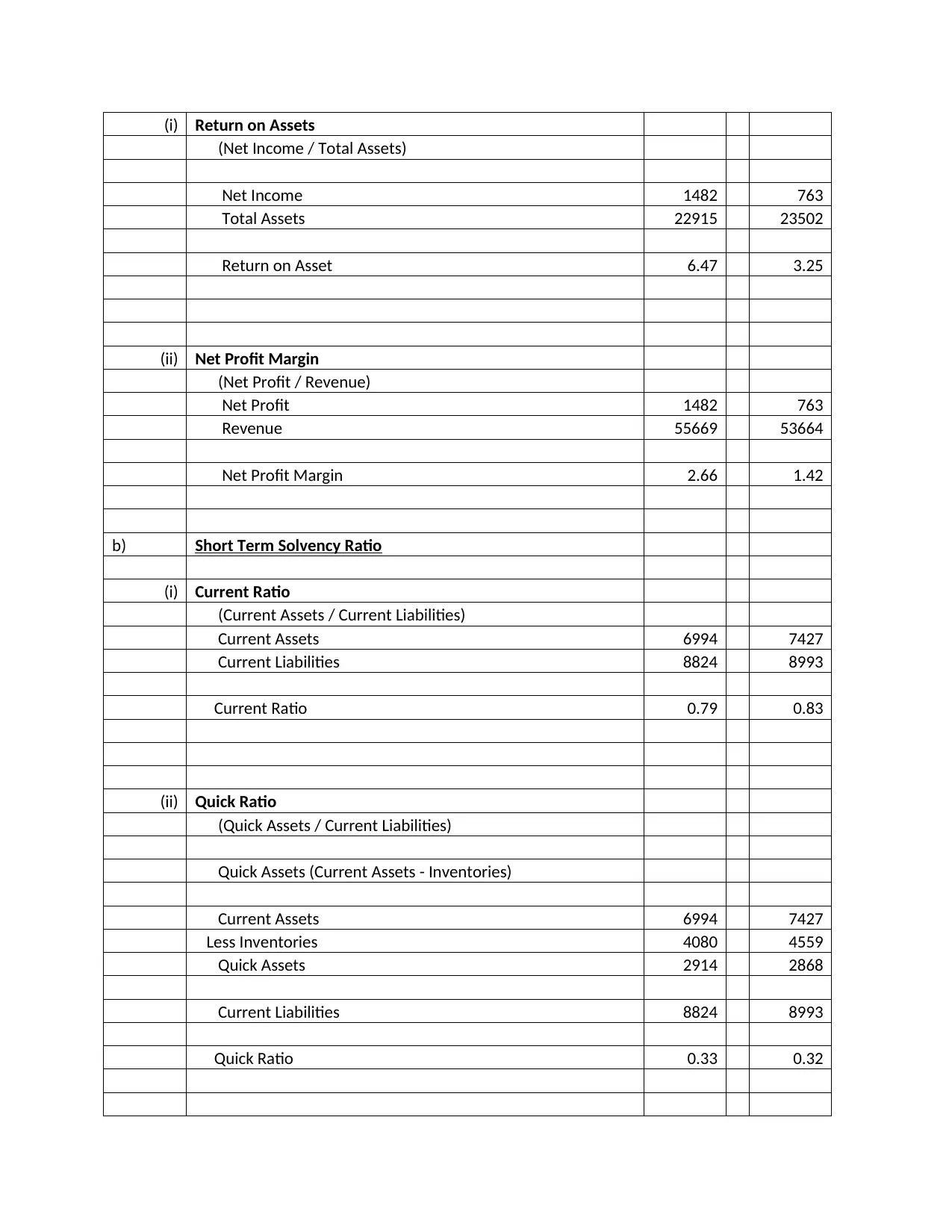
(i) Return on Assets
(Net Income / Total Assets)
Net Income 1482 763
Total Assets 22915 23502
Return on Asset 6.47 3.25
(ii) Net Profit Margin
(Net Profit / Revenue)
Net Profit 1482 763
Revenue 55669 53664
Net Profit Margin 2.66 1.42
b) Short Term Solvency Ratio
(i) Current Ratio
(Current Assets / Current Liabilities)
Current Assets 6994 7427
Current Liabilities 8824 8993
Current Ratio 0.79 0.83
(ii) Quick Ratio
(Quick Assets / Current Liabilities)
Quick Assets (Current Assets - Inventories)
Current Assets 6994 7427
Less Inventories 4080 4559
Quick Assets 2914 2868
Current Liabilities 8824 8993
Quick Ratio 0.33 0.32
(Net Income / Total Assets)
Net Income 1482 763
Total Assets 22915 23502
Return on Asset 6.47 3.25
(ii) Net Profit Margin
(Net Profit / Revenue)
Net Profit 1482 763
Revenue 55669 53664
Net Profit Margin 2.66 1.42
b) Short Term Solvency Ratio
(i) Current Ratio
(Current Assets / Current Liabilities)
Current Assets 6994 7427
Current Liabilities 8824 8993
Current Ratio 0.79 0.83
(ii) Quick Ratio
(Quick Assets / Current Liabilities)
Quick Assets (Current Assets - Inventories)
Current Assets 6994 7427
Less Inventories 4080 4559
Quick Assets 2914 2868
Current Liabilities 8824 8993
Quick Ratio 0.33 0.32
⊘ This is a preview!⊘
Do you want full access?
Subscribe today to unlock all pages.

Trusted by 1+ million students worldwide
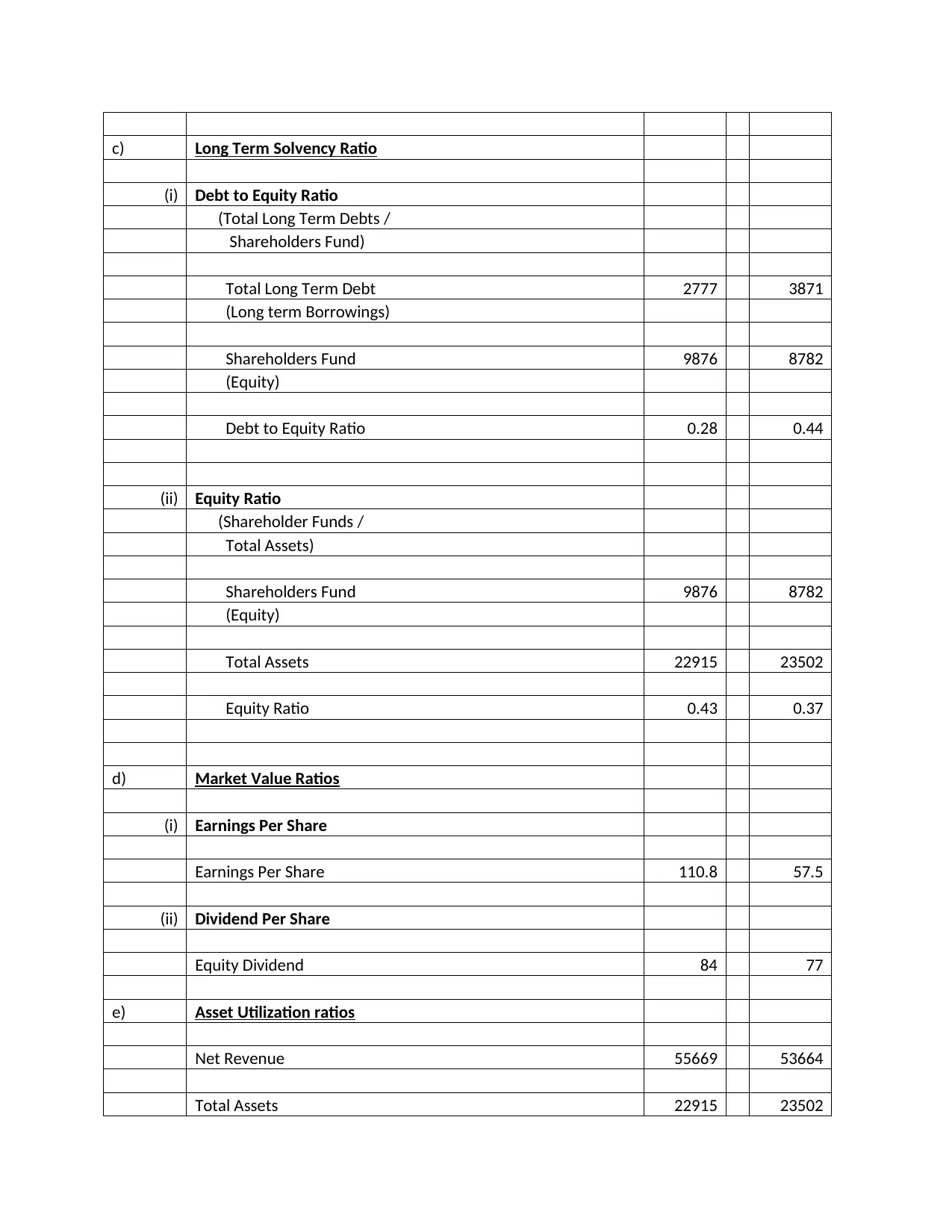
c) Long Term Solvency Ratio
(i) Debt to Equity Ratio
(Total Long Term Debts /
Shareholders Fund)
Total Long Term Debt 2777 3871
(Long term Borrowings)
Shareholders Fund 9876 8782
(Equity)
Debt to Equity Ratio 0.28 0.44
(ii) Equity Ratio
(Shareholder Funds /
Total Assets)
Shareholders Fund 9876 8782
(Equity)
Total Assets 22915 23502
Equity Ratio 0.43 0.37
d) Market Value Ratios
(i) Earnings Per Share
Earnings Per Share 110.8 57.5
(ii) Dividend Per Share
Equity Dividend 84 77
e) Asset Utilization ratios
Net Revenue 55669 53664
Total Assets 22915 23502
(i) Debt to Equity Ratio
(Total Long Term Debts /
Shareholders Fund)
Total Long Term Debt 2777 3871
(Long term Borrowings)
Shareholders Fund 9876 8782
(Equity)
Debt to Equity Ratio 0.28 0.44
(ii) Equity Ratio
(Shareholder Funds /
Total Assets)
Shareholders Fund 9876 8782
(Equity)
Total Assets 22915 23502
Equity Ratio 0.43 0.37
d) Market Value Ratios
(i) Earnings Per Share
Earnings Per Share 110.8 57.5
(ii) Dividend Per Share
Equity Dividend 84 77
e) Asset Utilization ratios
Net Revenue 55669 53664
Total Assets 22915 23502
Paraphrase This Document
Need a fresh take? Get an instant paraphrase of this document with our AI Paraphraser
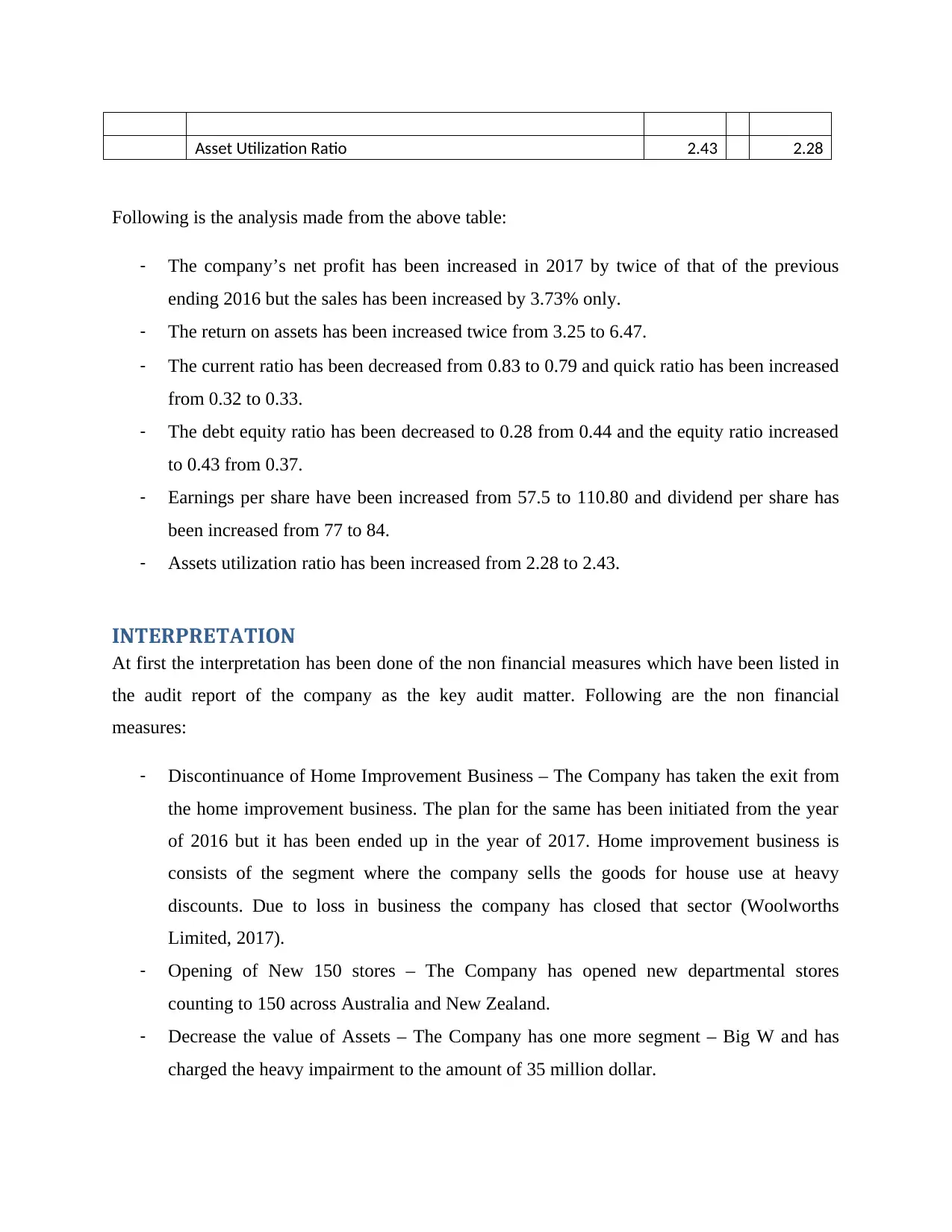
Asset Utilization Ratio 2.43 2.28
Following is the analysis made from the above table:
- The company’s net profit has been increased in 2017 by twice of that of the previous
ending 2016 but the sales has been increased by 3.73% only.
- The return on assets has been increased twice from 3.25 to 6.47.
- The current ratio has been decreased from 0.83 to 0.79 and quick ratio has been increased
from 0.32 to 0.33.
- The debt equity ratio has been decreased to 0.28 from 0.44 and the equity ratio increased
to 0.43 from 0.37.
- Earnings per share have been increased from 57.5 to 110.80 and dividend per share has
been increased from 77 to 84.
- Assets utilization ratio has been increased from 2.28 to 2.43.
INTERPRETATION
At first the interpretation has been done of the non financial measures which have been listed in
the audit report of the company as the key audit matter. Following are the non financial
measures:
- Discontinuance of Home Improvement Business – The Company has taken the exit from
the home improvement business. The plan for the same has been initiated from the year
of 2016 but it has been ended up in the year of 2017. Home improvement business is
consists of the segment where the company sells the goods for house use at heavy
discounts. Due to loss in business the company has closed that sector (Woolworths
Limited, 2017).
- Opening of New 150 stores – The Company has opened new departmental stores
counting to 150 across Australia and New Zealand.
- Decrease the value of Assets – The Company has one more segment – Big W and has
charged the heavy impairment to the amount of 35 million dollar.
Following is the analysis made from the above table:
- The company’s net profit has been increased in 2017 by twice of that of the previous
ending 2016 but the sales has been increased by 3.73% only.
- The return on assets has been increased twice from 3.25 to 6.47.
- The current ratio has been decreased from 0.83 to 0.79 and quick ratio has been increased
from 0.32 to 0.33.
- The debt equity ratio has been decreased to 0.28 from 0.44 and the equity ratio increased
to 0.43 from 0.37.
- Earnings per share have been increased from 57.5 to 110.80 and dividend per share has
been increased from 77 to 84.
- Assets utilization ratio has been increased from 2.28 to 2.43.
INTERPRETATION
At first the interpretation has been done of the non financial measures which have been listed in
the audit report of the company as the key audit matter. Following are the non financial
measures:
- Discontinuance of Home Improvement Business – The Company has taken the exit from
the home improvement business. The plan for the same has been initiated from the year
of 2016 but it has been ended up in the year of 2017. Home improvement business is
consists of the segment where the company sells the goods for house use at heavy
discounts. Due to loss in business the company has closed that sector (Woolworths
Limited, 2017).
- Opening of New 150 stores – The Company has opened new departmental stores
counting to 150 across Australia and New Zealand.
- Decrease the value of Assets – The Company has one more segment – Big W and has
charged the heavy impairment to the amount of 35 million dollar.
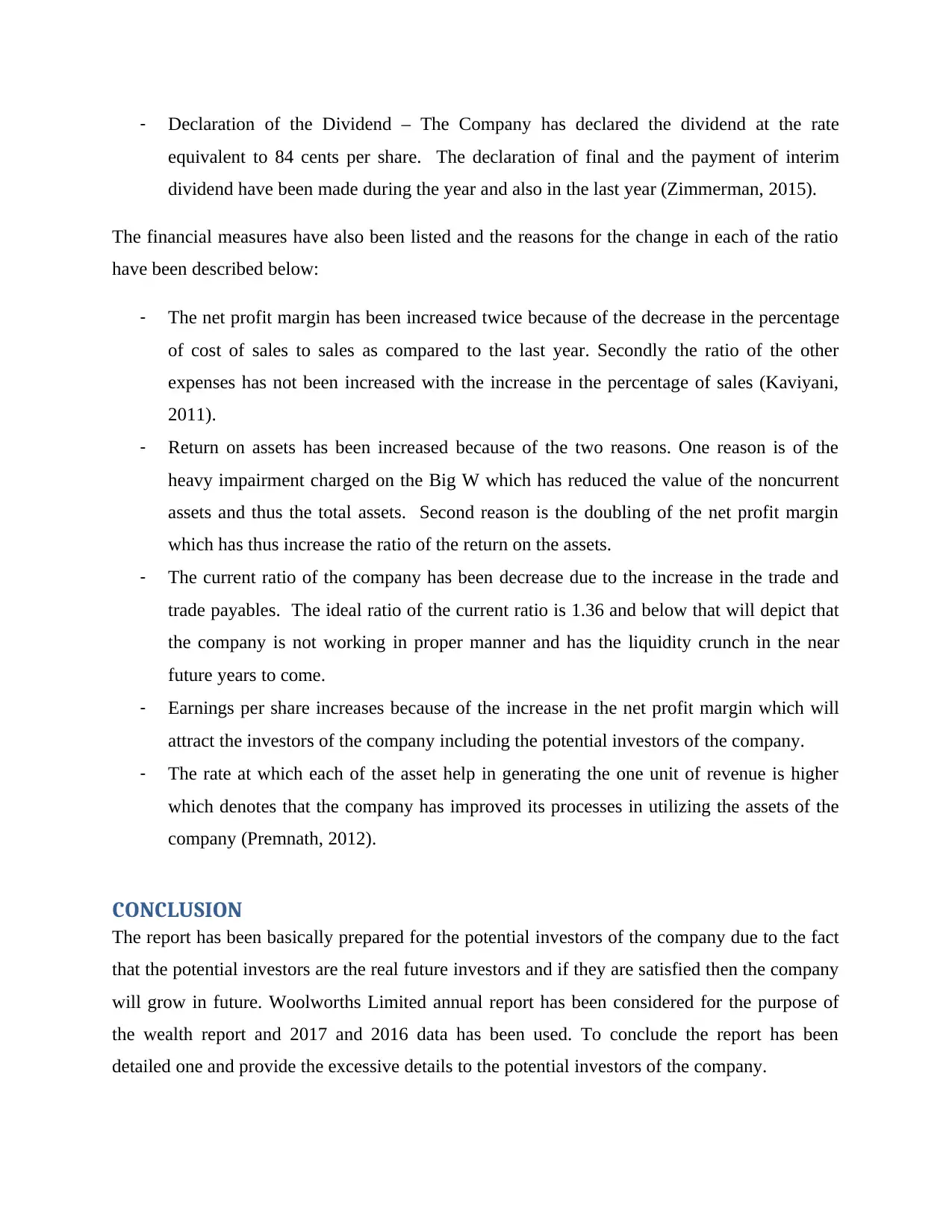
- Declaration of the Dividend – The Company has declared the dividend at the rate
equivalent to 84 cents per share. The declaration of final and the payment of interim
dividend have been made during the year and also in the last year (Zimmerman, 2015).
The financial measures have also been listed and the reasons for the change in each of the ratio
have been described below:
- The net profit margin has been increased twice because of the decrease in the percentage
of cost of sales to sales as compared to the last year. Secondly the ratio of the other
expenses has not been increased with the increase in the percentage of sales (Kaviyani,
2011).
- Return on assets has been increased because of the two reasons. One reason is of the
heavy impairment charged on the Big W which has reduced the value of the noncurrent
assets and thus the total assets. Second reason is the doubling of the net profit margin
which has thus increase the ratio of the return on the assets.
- The current ratio of the company has been decrease due to the increase in the trade and
trade payables. The ideal ratio of the current ratio is 1.36 and below that will depict that
the company is not working in proper manner and has the liquidity crunch in the near
future years to come.
- Earnings per share increases because of the increase in the net profit margin which will
attract the investors of the company including the potential investors of the company.
- The rate at which each of the asset help in generating the one unit of revenue is higher
which denotes that the company has improved its processes in utilizing the assets of the
company (Premnath, 2012).
CONCLUSION
The report has been basically prepared for the potential investors of the company due to the fact
that the potential investors are the real future investors and if they are satisfied then the company
will grow in future. Woolworths Limited annual report has been considered for the purpose of
the wealth report and 2017 and 2016 data has been used. To conclude the report has been
detailed one and provide the excessive details to the potential investors of the company.
equivalent to 84 cents per share. The declaration of final and the payment of interim
dividend have been made during the year and also in the last year (Zimmerman, 2015).
The financial measures have also been listed and the reasons for the change in each of the ratio
have been described below:
- The net profit margin has been increased twice because of the decrease in the percentage
of cost of sales to sales as compared to the last year. Secondly the ratio of the other
expenses has not been increased with the increase in the percentage of sales (Kaviyani,
2011).
- Return on assets has been increased because of the two reasons. One reason is of the
heavy impairment charged on the Big W which has reduced the value of the noncurrent
assets and thus the total assets. Second reason is the doubling of the net profit margin
which has thus increase the ratio of the return on the assets.
- The current ratio of the company has been decrease due to the increase in the trade and
trade payables. The ideal ratio of the current ratio is 1.36 and below that will depict that
the company is not working in proper manner and has the liquidity crunch in the near
future years to come.
- Earnings per share increases because of the increase in the net profit margin which will
attract the investors of the company including the potential investors of the company.
- The rate at which each of the asset help in generating the one unit of revenue is higher
which denotes that the company has improved its processes in utilizing the assets of the
company (Premnath, 2012).
CONCLUSION
The report has been basically prepared for the potential investors of the company due to the fact
that the potential investors are the real future investors and if they are satisfied then the company
will grow in future. Woolworths Limited annual report has been considered for the purpose of
the wealth report and 2017 and 2016 data has been used. To conclude the report has been
detailed one and provide the excessive details to the potential investors of the company.
⊘ This is a preview!⊘
Do you want full access?
Subscribe today to unlock all pages.

Trusted by 1+ million students worldwide
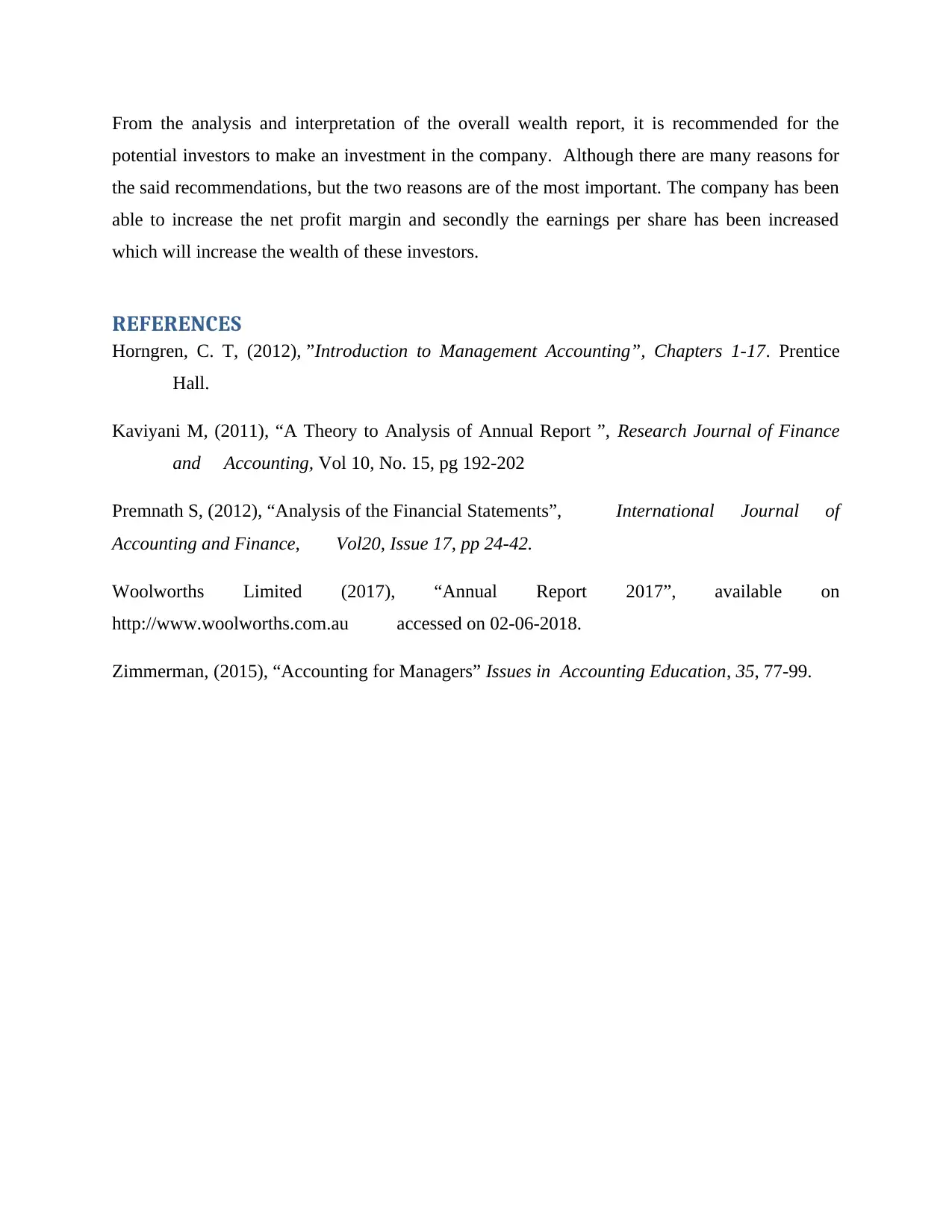
From the analysis and interpretation of the overall wealth report, it is recommended for the
potential investors to make an investment in the company. Although there are many reasons for
the said recommendations, but the two reasons are of the most important. The company has been
able to increase the net profit margin and secondly the earnings per share has been increased
which will increase the wealth of these investors.
REFERENCES
Horngren, C. T, (2012), ”Introduction to Management Accounting”, Chapters 1-17. Prentice
Hall.
Kaviyani M, (2011), “A Theory to Analysis of Annual Report ”, Research Journal of Finance
and Accounting, Vol 10, No. 15, pg 192-202
Premnath S, (2012), “Analysis of the Financial Statements”, International Journal of
Accounting and Finance, Vol20, Issue 17, pp 24-42.
Woolworths Limited (2017), “Annual Report 2017”, available on
http://www.woolworths.com.au accessed on 02-06-2018.
Zimmerman, (2015), “Accounting for Managers” Issues in Accounting Education, 35, 77-99.
potential investors to make an investment in the company. Although there are many reasons for
the said recommendations, but the two reasons are of the most important. The company has been
able to increase the net profit margin and secondly the earnings per share has been increased
which will increase the wealth of these investors.
REFERENCES
Horngren, C. T, (2012), ”Introduction to Management Accounting”, Chapters 1-17. Prentice
Hall.
Kaviyani M, (2011), “A Theory to Analysis of Annual Report ”, Research Journal of Finance
and Accounting, Vol 10, No. 15, pg 192-202
Premnath S, (2012), “Analysis of the Financial Statements”, International Journal of
Accounting and Finance, Vol20, Issue 17, pp 24-42.
Woolworths Limited (2017), “Annual Report 2017”, available on
http://www.woolworths.com.au accessed on 02-06-2018.
Zimmerman, (2015), “Accounting for Managers” Issues in Accounting Education, 35, 77-99.
1 out of 7
Related Documents
Your All-in-One AI-Powered Toolkit for Academic Success.
+13062052269
info@desklib.com
Available 24*7 on WhatsApp / Email
![[object Object]](/_next/static/media/star-bottom.7253800d.svg)
Unlock your academic potential
Copyright © 2020–2025 A2Z Services. All Rights Reserved. Developed and managed by ZUCOL.





